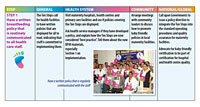|
|
|
Step 1: Have a written breastfeeding policy that is routinely communicated to all health care staff.
Every facility providing maternity services and care for newborn infants should:
Step 1: Have a written breastfeeding policy that is routinely communicated to all health care staff.
The health facility should have a written breastfeeding policy that addresses all 10 steps and protects breastfeeding...[it] should be available so that all staff who take care of mothers and babies can refer to it... should be visibly posted in all areas of the health care facility which serve mothers, infants, and/or children...and should be displayed in the language(s) most commonly understood by patients and staff.
The 10 steps call for health facilities to have written policies that are displayed for all to read, indicating that staff is committed to implementing them.
The first step is to have a written breastfeeding policy in English and the local languages. It addresses all the ten steps and states that the hospital does not accept free or subsidized supplies of infant formula and feeding bottles.
The policy is communicated to the hospital administration as well as to all the health workers in the maternity setting.
|
What You Can Do.
 Step 1: WABA Action Chart Step 1: WABA Action Chart
What You or Your Organisation Can Do >> click here
World Breastfeeding Week Action Folders  >> English - Spanish >> English - Spanish
- General
The Ten Steps call for health facilities to have written policies that are displayed for all to read, indicating that staff is committed to implementing them.
- Health System
Visit maternity hospitals, health centres and primary care facilities and see if policies covering the Ten Steps are displayed.
Ask health service managers if they have developed a policy, and explain how the Ten Steps are now considered "best practice". Tell them about the new BFHI materials, especially Section 1 on implementation.
- Community
Arrange meetings with community leaders to discuss how to promote baby friendly policies in local maternity facilities.
- National / Global
Call upon Governments to issue a policy directive to integrate the Ten Steps into the standard operating procedures and quality assurance for maternity facilities.
Advocate for baby-friendly certification to be part of certification for hospital and health centre quality.
|
Key Points:
 |
Why have a policy?
- Requires a course of action and provides guidance
- Helps establish consistent care for mothers and babies
- Provides a standard that can be evaluated
What should a Breastfeeding Policy Cover?
- Should include the Ten Steps to Successful Breastfeeding
- Should include an institutional ban on acceptance of free or low cost supplies of breast-milk substitutes, bottles, teats, gifts, samples or coupons, and use of materials distributed by formula companies
How to Present the Policy
- Use plain language to address each step
- Senior responsible nursing officer on maternity duty should be able to locate a copy of the policy and describe how the other staff are made aware of it
- Make it available to all staff caring for mothers and babies
- Post or display it in areas where mothers and babies are cared for
|
Develop policies that promote breastfeeding as the preferred method of infant nutrition
- All interventions and care plans should protect this valuable resource
- Decisions to interrupt breastfeeding or withhold human milk should be evidence based
- Policies should be communicated to staff upon employment and updated on a regular basis
HIV Issues to Consider Step 1: Have a written breastfeeding policy that is routinely communicated to all health care staff. Step 1: Have a written breastfeeding policy that is routinely communicated to all health care staff.
Issues to consider while implementing this step in relation to feeding recommendations for children of HIV-infected mothers and for settings with high HIV prevalence.
- The hospital policy should promote, protect and support breastfeeding irrespective of the HIV infection rate within the population.
- The policy will need to be adapted so that providing appropriate support in the context of HIV is addressed.
- The policy should require the training of staff in HIV and infant feeding counseling.
- The policy should include a recommendation that all pregnant and lactating women be offered or referred for HIV testing & counseling.
- The policy should require that the hospital offer counseling for HIV-positive pregnant women about feeding options.
- The policy should stress that full compliance with the "Code of Marketing of Breast-milk Substitutes" or a similar national measure is essential.
- The issue of confidentiality should be addressed in the policy.
- If there is a national level policy on infant feeding in the context of HIV the hospital policy should incorporate the national guidelines.
16 June, 2014
|
